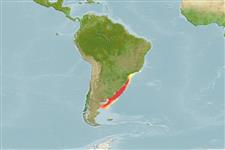分類 / Names
共通名の | 類義語 | Catalog of Fishes(部類, 種) | ITIS | CoL | WoRMS | Cloffa
板鰓亜鋼(サメとエイ類) (sharks and rays) >
Squatiniformes (Angel sharks) >
Squatinidae (Angel sharks)
Etymology: Squatina: Latin for skate, which angel sharks superficially resemble, presumably tautonymous with Squalus squatina Linnaeus 1758 (no species mentioned). (See ETYFish); guggenheim: In honor of the Guggenheim Institución (presumably the present-day John Simon Guggenheim Foundation), which apparently funded the “study trip” (translation) that led to the description of this species. (See ETYFish).
Environment: milieu / climate zone / depth range / distribution range
生態学
海; 汽水性の 底生の; 深さの範囲 4 - 360 m (Ref. 57911), usually 4 - 266 m (Ref. 55667). Subtropical; 20°S - 45°S, 68°W - 40°W (Ref. 57911)
Southwest Atlantic: southern Brazil and Argentina.
Length at first maturity / サイズ / 重さ / 年齢
Maturity: Lm 74.2 range ? - ? cm
Max length : 129 cm TL オス/雌雄の選別がない; (Ref. 57911); 130.0 cm TL (female); common length : 89.0 cm TL オス/雌雄の選別がない; (Ref. 55667)
簡単な記述
形態学 | 形態計測学
This species is distinguished by the following characters: with a single (or multiple in juveniles) row of enlarged, conical and morphologically distinct dermal denticles over dorsal longitudinal midline, from midlength of the pectoral fin base to origin of first dorsal fin (in some specimens, to origin of caudal fin); dorsal midline denticles are with enlarged and rounded basal plate, 3-4 times diameter of other dorsal denticles, crown with several median ridges (10-12), and crown apex acute and smooth, without ridges (vs. dorsal midline denticles on trunk morphologically similar to other trunk denticles and barely organized in a row in S. occulta and S. argentina); differs from S. occulta by having larger and fewer white blotches on dorsal surface, without surrounding blackish rings (i.e. absence of ocelli-like markings) and smaller in size at maturity, from 73.0-80.0 cm TL (vs. greater than 100.0 cm TL in S. occulta);
differs from S. argentina by its ligther background colour, light to dark brown (vs. dark brown to reddish brown), with larger and fewer white blotches over dorsal surface, with a pair of enlarged, conical and morphologically distinct dermal denticles between spiracles (vs. interspiracular surface covered by smaller dorsal denticles, no enlarged denticles), the lower number of tooth rows with 18-22 vertical rows in both upper and lower jaws, tooth formula 9-9 to 11-11/9-9 to 11-11 (vs. 12-12/12-12 in i>S. argentina), and with a straight external pectoral fin margin (vs. with convex anterior half of external margin). Colouration: dorsal color pattern of light to dark brown background, with several white, creamy-white or yellowish large and rounded blotches variable in size (between one-half to 1.5 times eye-length) on entire dorsal surface (Ref. 95520).
Bony fishes were the main food followed by crustaceans and molluscs (Ref. 55667). Ovoviviparous (Ref. 50449). Adult males are characterized by the presence of a patch of small spines near the tip of the pectoral fins (Ref. 86510).
Life cycle and mating behavior
成熟 | 繁殖 | 放精 | 卵 | 生産力 | 幼生
Ovoviviparous, embryos feed solely on yolk (Ref. 50449). Only the left ovary is functional (Ref. 57911).
Vaz, D.F.B. and M.R. De Carvalho, 2013. Morphological and taxonomic revision of species of Squatina from the Southwestern Atlantic Ocean (Chondrichthyes: Squatiniformes: Squatinidae). Zootaxa 3695(1):001-081. (Ref. 95520)
IUCNのレッドリストの状況は (Ref. 130435)
絶滅危惧 (EN) (A2bd); Date assessed: 07 June 2018
Human uses
より多くの情報
Age/Size成長体長-重さLength-length体長組成形態計測学形態学幼生幼生の動力補充豊度BRUVS
参考文献水産養殖水産養殖の紹介緊張遺伝子のElectrophoreses遺伝病気行列NutrientsMass conversion
協力者画像Stamps, Coins Misc.音シガテラ(食中毒の名前)速度泳ぐ 型式カマOtoliths脳視覚
用具
特記事項
XMLをダウンロードして下さい
インターネットの情報源
Estimates based on models
Preferred temperature (Ref.
123201): 11.7 - 20.4, mean 15.8 °C (based on 228 cells).
Phylogenetic diversity index (Ref.
82804): PD
50 = 0.5000 [Uniqueness, from 0.5 = low to 2.0 = high].
Bayesian length-weight: a=0.00676 (0.00293 - 0.01558), b=3.07 (2.88 - 3.26), in cm total length, based on LWR estimates for this Genus-body shape (Ref.
93245).
栄養段階 (Ref.
69278): 4.4 ±0.80 se; based on food items.
回復力 (Ref.
120179): 非常に低い, 14年以上の倍増期間の最小個体群 (Fec=4-10).
Fishing Vulnerability (Ref.
59153): Very high vulnerability (78 of 100).
Nutrients (Ref.
124155): Calcium = 18.6 [3.4, 85.9] mg/100g; Iron = 0.762 [0.196, 2.146] mg/100g; Protein = 20.1 [18.0, 22.1] %; Omega3 = 0.441 [0.196, 0.945] g/100g; Selenium = 26.6 [7.5, 70.5] μg/100g; VitaminA = 11.3 [4.1, 33.1] μg/100g; Zinc = 0.478 [0.237, 0.881] mg/100g (wet weight);
